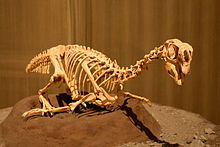Conchoraptor gracilis
|
Conchoraptor Temporal range: Late Cretaceous |
|
|---|---|
 |
|
| Cast mounted in a nesting position | |
| Scientific classification | |
| Kingdom: | Animalia |
| Phylum: | Chordata |
| Clade: | Dinosauria |
| Order: | Saurischia |
| Suborder: | Theropoda |
| Family: | †Oviraptoridae |
| Genus: |
†Conchoraptor Barsbold, 1986 |
| Species: | †C. gracilis |
| Binomial name | |
|
Conchoraptor gracilis Barsbold, 1986 |
|
Conchoraptor (meaning "conch plunderer") is a genus of oviraptorid dinosaur from the late Cretaceous Period of what is now Asia.
Conchoraptor was a small dinosaur, only 1–2 meters (3.3-6.6 feet) in length. Unlike many other oviraptorids, Conchoraptor lacked a head crest. Like its relatives, it lacked teeth. Instead of teeth, oviraptorids had powerful beaks, possibly adapted to crushing mollusk shells. The skull of Conchoraptor was heavily pneumatised, with most of the bones hollow. Internal connections between both ears functioned as resonance chambers and improved hearing.
When first discovered in the Red Beds of Hermiin Tsav of the Early Maastrichtian Nemegt Formation by a Polish-Mongolian expedition in 1971, scientists believed that Conchoraptor was a juvenile Oviraptor and that the animal's missing crest would have begun to grow when the animal reaching sexual maturity. Further study of multiple skeletons showed that Conchoraptor belonged in a new genus. The hands of Conchoraptor were a major reason that scientists decided to split it off from Oviraptor. Anatomically the hands seemed to be an evolutionary intermediate between those of Ajancingenia and Oviraptor, making it obvious that this animal was not a member of a known species.
The type species of this new genus, Conchoraptor gracilis, was described and named by Barsbold, in 1986. The generic name is derived from Greek konkhè, "mussel", and Latin raptor, "plunderer". This name reflects Barsbold's hypothesis that oviraptorids, rather than preying primarily upon eggs as had been traditionally thought, may have been specialized to feed on mollusks. The specific name means "gracile" in Latin. The holotype is IGM 100/20, a partial skeleton with skull. Later about two dozen specimens were formally referred to the species.
...
Wikipedia
